Connections
Overview
Connections are a library of credentials that establish authentication for direct communication between IntelliBuddies and an external system.
You can manage all your automation connections to external systems on the Assets > Connections page inside the Control Room.
Context Menu Options
You must have appropriate permissions to access and perform operations on the Connections page.
| Option | Description |
|---|---|
| View | View all Connections and their details |
| Edit | Edit Connection details. |
| Delete | Deletes the selected Connection. |
| Clone | Clones the selected Connection |
| Audit | Shows the audit logs for the selected Connection |
Adding a Connection
You must have Add Connections permissions to add a new Connection.
- Login to the Control Room
- Select Assets > Connections option from side panel
- Click on Toolbar-Menu >
button.
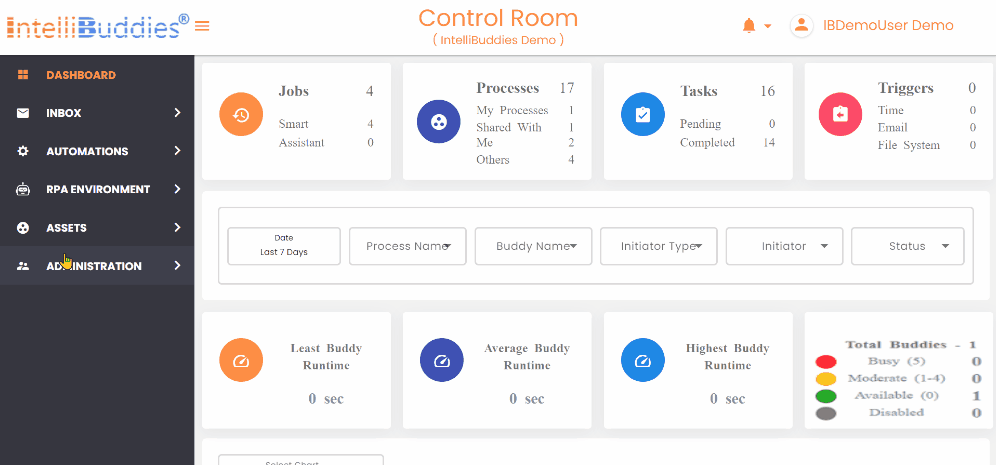
-
Choose the appropriate application by clicking on the icon in the New Connection dialog.
-
Configure the selected application connection by providing details.
-
Click on Test Connection to check the connection.
-
Once the Test Connection is successful, click on Add button to add the connection.
Microsoft SQL Server
Once you select this option, the following screen is where you can provide SQL Server connection configuration.

- Name – Specify a unique name to identify your Connection.
- Description – You can specify a brief description of your Connection.
- Database Server Name – Specify the SQL Server database server name or IP address
- Database Name – Specify the database name to which you want to connect.
- SSPI (Integrated Security) – Check this option to log in to SQL Server using Windows authentication. If you select this option, you don't have to specify the credentials.
- User Name – Specify the user name for connecting to the database.
- Password - Specify the password for the user name.
PostgreSQL
Once you select this option, you can provide PostgreSQL connection configuration on the following screen.
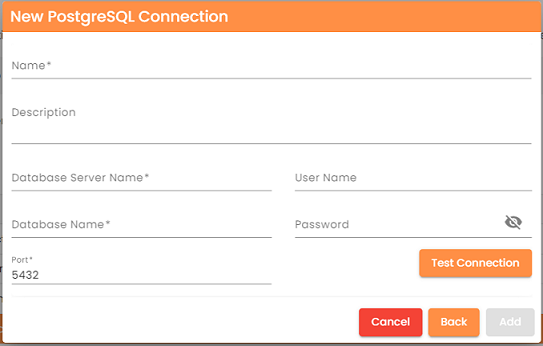
- Name – Specify a unique name to identify your Connection.
- Description – You can specify a brief description of your Connection.
- Database Server Name – Specify the PostgreSQL Server name or IP address
- Database Name – Specify the database name to which you want to connect.
- Port – Specify the port number to connect to the PostgreSQL server.
- User Name – Specify the user name for connecting to the database.
- Password - Specify the password for the user name.
MySQL
Once you select this option, the following screen is where you can provide MySQL connection configuration.

- Name – Specify a unique name to identify your Connection.
- Description – You can specify a brief description of your Connection.
- Database Server Name – Specify the MySQL Server name or IP address
- Database Name – Specify the database name to which you want to connect.
- Port – Specify the port number to connect to the MySQL server.
- User Name – Specify the user name for connecting to the database.
- Password - Specify the password for the user name.
Oracle
Once you select this option, the following screen is where you can provide Oracle connection configuration.

- Name – Specify a unique name to identify your Connection.
- Description – You can specify a brief description of your Connection.
- Database Server Name – Specify the Oracle Server name or IP address
- Database Name – Specify the Service ID (SID) here.
- Port – Specify the port number to connect to the Oracle server.
- User Name – Specify the user name for connecting to the database.
- Password - Specify the password for the user name.
File System
After selecting this option, you can configure the File System connection on the following screen.
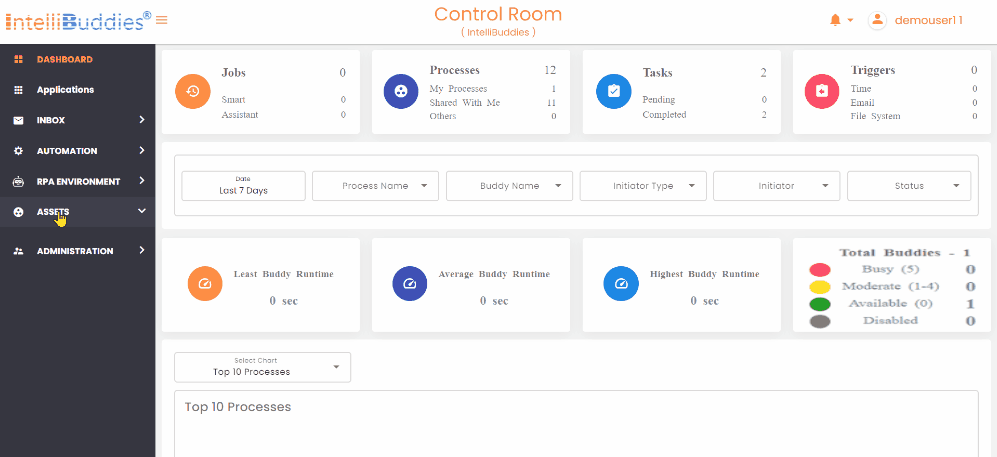
- Name – Specify a unique name to identify your Connection.
- Description – You can specify a brief description of your connectionConnection.
- Folder Path – Specify the target folder path for the file upload. A network or absolute folder path having Control Room Server access.
- User Name – Specify the user name for connecting to the File Path.
- Password - Specify the password for the user name.
OpenAI
Once you select this option, you can provide OpenAI connection configuration on the following screen.
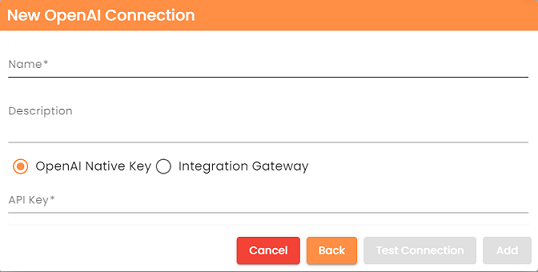
- Name – Specify a unique name to identify your Connection.
- Description – You can briefly describe your Connection.
- OpenAI Native Key - Select this option to use your own OpenAI key. - API Key - Specify the API Key provided by OpenAI.
- Integration Gateway—Select this option to utilize the OpenAI Chat Service through IntelliBuddies Integration Gateway. No API key is required if you choose this option. You can purchase OpenAI Chat Service credits through your subscription based on your organization's requirements.
Llama
Once you select this option, the following screen is where you can provide Llama connection configuration.

- Name – Specify a unique name to identify your Connection.
- Description – You can specify a brief description of your Connection.
| Options | Description |
|---|---|
| Llama Native Key | Select this option to use your own Llama key. - Endpoint URL – Specify the deployed endpoint URL of the chosen Llama service. - API Key — Specify the API Key associated with the deployed service corresponding to the deployed service. Below are the details for generating an API Key. - Generating Llama API Key |
| Integration Gateway | Select this option if you want to use Llama Chat Service via IntelliBuddies Integration Gateway. You don't have to provide any endpoint URL or API key if you select this option. Just buy Llama Chat Service Credits in your organization. - Model – This option is accessible only when Integration Gateway is selected. It provides a list of all Llama models supported by IntelliBuddies Integration Gateway. |
Azure
Once you select this option, you can provide Azure connection configuration on the following screen.
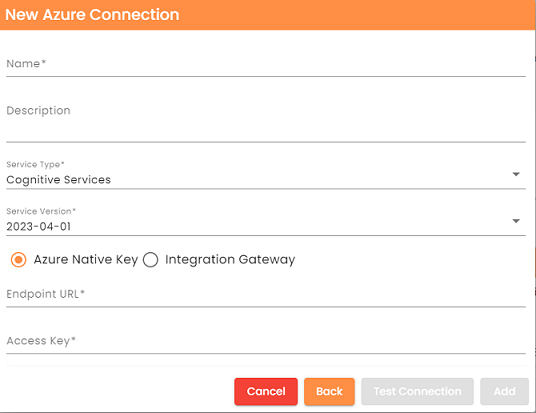
- Name – Specify a unique name to identify your Connection.
- Description – You can specify a brief description of your Connection.
- Service Type - Choose the Azure service type you want to connect from the dropdown. The following options are currently available.
| Type | Description |
|---|---|
| Cognitive Services | Connect to Azure Cognitive Service end points. |
| Document Analysis | Connect to Azure Document Analysis service end points. |

- Service Version - Specify the version of the selected service.
- Azure Native Key - Select this option to use your deployed Azure Services. - Endpoint URL – Specify the deployed endpoint URL of the Azure Cognitive/Document service instance. - Access Key – Specify the Access Key corresponding to the deployed service.
- Integration Gateway—Select this option if you want to use Azure Cognitive Service or Azure Document Analysis Service via IntelliBuddies Integration Gateway. You don't have to provide an endpoint and access key if you select this option. Just buy Azure Cognitive Service or Azure Document Analysis Service credits in your subscription based on your organization's needs.
Email Server
Selecting this option will direct you to a screen where you can configure the Email Server connection.
Configurations for POP3 and IMAP
If you select POP3 as the Email Server Connection type, please review the limitation. It is recommended to consider more efficient alternatives for improved performance.

- Name – Provide a distinctive name to identify your Connection.
- Description – Optionally, concisely describe your Connection.
- Server Type - Select the type of email server. Options include POP3, IMAP, and Outlook.
- Host - Specify the hostname or URL of the email server.
- Port - Specify the listening port number of the email server.
- Email Address - Specify the login email account.
- Password - Specify the password to log in.
- Require SSL - Check this box if the email server requires SSL for communication.
Configurations for Outlook

- Tenant ID (Directory ID) – Specify the tenant ID of the Microsoft 365 Tenant. For guidance, refer to Registering App and gathering Tenant Id
- Client Id (Application Id) – Specify the client id of the registered app. For assistance, refer to Registering App and gathering Client Id
- Client Secret – Specify the client secret of the registered app. For instructions, refer to Create and gather Client Secret
- Email Address – Specify the email address to retrieve the mail messages.
- Mail Folder – Specify the mail folder to retrieve the messages.
View Connection
- Login to the Control Room
- Select Assets > Connections option from side panel
- Select the Connection to view from the data panel
- Right-click and select View
- You can view the selected Connection configuration in read-only mode.
Editing a Connection
- Login to the Control Room
- Select Assets > Connections option from side panel
- Select the Connection to modify from the data panel
- Right-click and select Edit
- Modify the connection properties and then click on the Update button
Cloning a Connection
You can clone a connection to a new one by following the steps below.
- Login to Control Room
- Select Assets > Connections option from side panel
- Select the Connection to clone from the data panel
- Right-click and click on Clone
- Specify a Name to the new connection
- Optionally, change the Description
- Click on Add
- The selected Connection will be cloned as a new connection.
Deleting a Connection
- Login to the Control Room
- Select Assets > Connections option from side panel
- Select the Connection to delete
- Right-click and select Delete
- On confirmation, the selected Connection gets deleted.
Deleting connections of type Microsoft SQL Server, PostgreSQL, MySQL, Oracle, or File System with any reference is prohibited. Instead, it shows a DataGrid displaying the Process Name and Version.
Auditing a Connection
- Login to the Control Room
- Select Assets > Connections option from side panel
- Select the Connection to audit
- Right-click and select Audit, which will bring up the audit logs for the selected Connection.